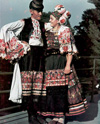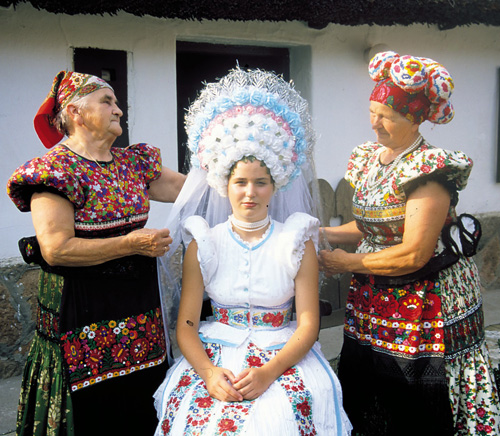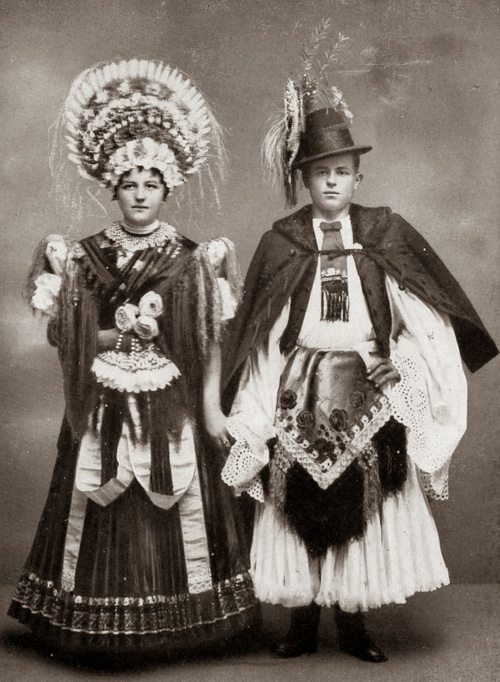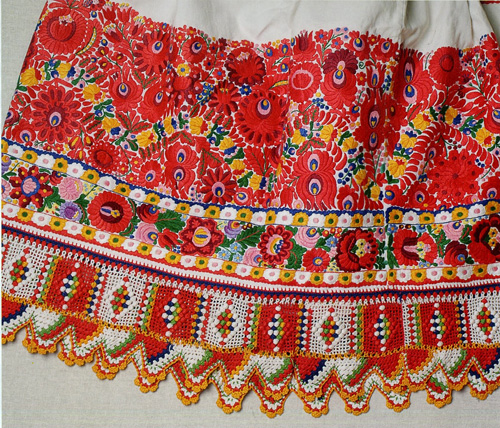 The folk costume of Hungary is rather diverse; it differs from the other Eastern-European national dresses. The Hungarian traditional outfit has a lot of Renaissance and Baroque features. But until the beginning of the 20th century, the folk clothing of Hungary was simpler and had fewer decorations. Only in the 1930s, colorful threads were added to the patterns, and the amount of embroidery was increased. Today, Hungarian folk dress is rarely used by locals. Though, it still is unique and outstanding.
The folk costume of Hungary is rather diverse; it differs from the other Eastern-European national dresses. The Hungarian traditional outfit has a lot of Renaissance and Baroque features. But until the beginning of the 20th century, the folk clothing of Hungary was simpler and had fewer decorations. Only in the 1930s, colorful threads were added to the patterns, and the amount of embroidery was increased. Today, Hungarian folk dress is rarely used by locals. Though, it still is unique and outstanding.
The traditional clothing of Hungary varies from region to region. We can divide the country into 4 main areas due to the clothing traditions and features of the national dress. They are Great Plain, Transdanubia, Transylvania, and Upper Hungary. Let’s talk about the clothing of each of the mentioned regions.
Great Plain
Cattle-breeding used to be one of the main crafts in Hungary. That’s why the traditional male costume in this country (especially for the Great Plain region) is a shepherd’s clothing. It usually consists of a shirt, trousers called “gatya”, a vest, an outerwear (a cloak, a fur coat, a waistcoat, etc.), a brimmed hat, and boots.
The shirt and trousers were white and loose, made of linen cloth. Later, men began to use blue shirts and trousers (after the soldiers of the Hungarian War of Independence in 1848–1849). In such a way, they honored their heroes. On white shirts and gatyas, there often was some embroidery. Shepherds rubbed ashes and tallow into the fabric to make it waterproof. Festive shirts of Hungarian men, especially after the 1930s, were richly decorated with colorful embroidery.
The assortment of outerwear in the Great Plain region was very wide. It could be a black sleeveless waistcoat with silver buttons, a sheepskin jacket that reached to below the waist, a frieze mantle called “szűr” used by poor men, a long and warm sheepskin cloak called “suba” or a cloak made from 6 skins and called “bunda”, and etc. Of course, most of the pieces used by shepherds were made from sheepskin or woolen cloth.
Hungarian males also wore different hats. The most widespread were a high-topped narrow-brimmed hat, a wide-brimmed shepherd’s hat, and a fur cap. The hats often were decorated with feathers, the wealthier a man the more expensive feathers he used. Shepherds liked their hats to be waterproof so that they could protect the owner on a rainy day. There were no accessible waterproof materials in the 18th-19th century; that’s why they rubbed lard into the fabric of the hats to make them waterproof. But it also made the hats very heavy.
The shoes of Hungarian men were leather high-heeled boots, sometimes with the spurs.

Traditional clothing of Matyo people. Matyo men are wearing their folk costumes, including shirts with wide and long richly embroidered sleeves, embroidered male aprons, and high hats. The photo from Folkcostume.blogspot.com
Women’s traditional costume of the Great Plain region had a lot of Baroque features. Females used very wide pleated skirts with many petticoats, embroidered shirts, aprons, an outerwear, shoes or boots, and headdresses.
The skirt was the brightest part of the outfit. It was wide and colorful (red, blue, green, etc.). In the middle of the 20th century, women wore fewer petticoats, so their skirts were already not so puffy. The skirt was always covered with an apron, adorned with floral pattern and often edged with white lace.
The women’s shirts were richly decorated. Pieces from the earlier period were embellished mostly with black or dark-blue embroidery, but after the 1930s, the shirts became colorful (with red, lilac, green, blue, and yellow patterns). Hungarian traditional female shirts and blouses were short. The hem of the shirt didn’t peek under the skirt, as in many other Slavic costumes. In some areas, the shirt had a collar with one frill (for little girls) or two frills (for older women).
Hungarian women from the Great Plain region, usually, wore black or dark vests and waistcoats as an outerwear. In summer, they also used broad cloaks or mantles adorned with appliqués. In winter, females preferred short sheepskin cloaks called “kis bunda”, long cloaks cut in Hungarian fashion, and suba or szűr (similar to men’s ones). Female’s outerwear, usually, was decorated with embroidery, appliqués, ribbons, or other decorations.
Unmarried girls in Hungary braided their hair and wore ribbons pinned to the hairdo. They also used headdresses similar to wreaths, and with ribbons. Married women wore embroidered bonnets or kerchiefs. But, in general, there were plenty of various interesting and unusual female headgears in this country.
If to talk about shoes, women used shoes in summer and boots in winter.
Transdanubia
The traditional costume of this region of Hungary got under the influence of neighboring countries: Croatia, Slovenia, and Serbia. Though the influence was mutual, and some features of the Hungarian folk dress can be found in other national attires.
In this region, the traditional clothing was brighter and has more embroidery. You could see some embroidery even on the male underpants, as well as the fringed bottom. Men’s folk costume consists of an embroidered shirt, wide trousers, a bodice or vest, a hat, and boots.
The older shirts were very short; they didn’t even cover the waist. In the middle of the 20th century, men began to wear longer shirts. The trousers called “gatya” were linen; of usual width for everyday usage, the festive drawers were very wide (5-6 widths of the usual amount of fabric). Trousers were decorated with embroidery and a fringe on the bottom.
The outerwear in the Transdanubia region looked like a bodice worn over a shirt, a sheepskin vest, a short szűr (frieze mantle used by poor men), or a usual szűr.
In some areas of Transdanubia, men wore very richly embellished outfits. Floral embroidery was popular among both men and women. So, male shirts could be very festive and colorful, with a lot of embroidery and ribbons. Also, male aprons were in use. They were embroidered with floral patterns as well.
Men in the Transdanubia region wore brimmed hats and small fur caps. On special occasions, they pinned large bouquets of flowers to the caps.
Males used shoes or boots as footwear.

Hungarian bride and older women in the traditional outfits. The photo from Folkcostume.blogspot.com
In Transdanubia, the folk costume of local women varied much not only from district to district but also from one village to another. The most interesting and diverse piece here was a headdress. Interesting fact: Hungarians have a very nice tradition of dividing women into unmarried girls, young wives (up to 35 or wives who don’t have kids yet), and married females (older women). In other Slavic countries, we can only distinguish an unmarried girl and a married woman by their headdress. Hungarian females have a wider variety of headgears that show the marital status.
The traditional women’s outfit in the Transdanubia region of Hungary, usually, consists of a linen embroidered shirt, a puffy linen skirt, an apron, a bodice, a waistcoat or other piece of the outerwear, shoes, and a headdress.
The shirt was short, usually just past the waist. But in some villages women used very short blouses which didn’t even reach the waist. The skirt was wide and puffy, often made from linen cloth. Festive skirts could be made of velvet as well. A skirt could be either plain or richly patterned but there were always many petticoats. Another variant of Hungarian female folk attire used in Transdanubia was a dress made from blue satin. An apron was, usually, worn with a skirt or a dress. Hungarian women often used festive silk aprons or linen ones with embroidery, patterns on the fabric, and lacing.
Women from the Transdanubia region of Hungary often used bodices made from linen, cotton, silk, or other fabrics. Sometimes it was one piece with a skirt and worn over a shirt and an underskirt.
The footwear for females from this region – red leather boots.
But Transdanubian women paid the most attention to their headdresses. There were plenty of them, made in various shapes, colors, and materials. Young girls, usually, wore one or two braids with ribbons in them (often those ribbons reached the heels of their boots). Another variant of a girl’s headgear was a ribbon tied over the forehead. But in some areas Hungarian unmarried females actually used a headdress. It was called “pille”; it was a kind of small beaded cap (on a rigid base).
Married women used kerchiefs, coifs, and other headdresses. For example, there was a headgear called “pacsa”; it was made from white linen, starched, and embellished. Women rolled their hair on a piece of wood or cardboard and wore the pacsa on top. Usually, the hair of a married woman was covered or at least knotted.
But young wives (in young age or without kids yet) had the privilege of avoiding coifs and kerchiefs. Actually, this tradition is very nice, as other Slavic countries don’t have such a tradition and their married women used to cover the hair, no matter how young and pretty they were. Hungarian young wives from the Transdanubia region used bright and gilded ribbons to tie over the forehead, while the hair was knotted into a bun. There were also certain headdresses for the married women of different age. Females up to 35 wore a red headgear with wide red ribbons; women from 35 to 40 years old added some blue ribbons to the red ones; females up to 50 used colorful ribbons (blue, green and white); and older women wore a white headdress without ribbons at all.
Transylvania
The folk costume of the Transylvanian region of Hungary has a lot of antique elements. This region has one peculiarity: the western influences barely got here. So, the traditional clothing of Transylvania is unique.
In Transylvania, men usually wore short shirts that barely reached the waist (similar to those used in other regions of Hungary). The shirt was belted with a wide sash called “tüsző” or “gyűszű”. It was a leather belt with a lot of decorations. The most vintage shirts used by men were loose, collarless and without cuffs, but later they were replaced by embroidered linen shirts with collars and cuffs.
Transylvanian men wore breeches or gatyas with the shirt. In some districts, they used very wide pleated trousers called “full gatya”. The breeches were usually tight and made from homespun cloth; later, the factory produced fabric was used. Transylvania was the only region where the breeches of ancient cut could be seen in the 19th-20th centuries. Such trousers were used in Western Europe in the 15th century. They were made from a homespun cloth and consisted of two legs not sewn together.
Very often, a dark vest was worn over a shirt. It could be made from leather, broadcloth, or fur. Usually, there were no or very few decorations on a male vest.
In some areas, a male neckerchief was popular. But they were not very widespread in Transylvania. Young men used white neckerchiefs while older men preferred black cravats.
Transylvanian males used various pieces of outerwear. The most popular was a sleeveless fur-coat made from sheepskin and embellished with embroidery. It is called “kuzsók”. This piece was comfy and warm, so men used to wear it for work. But they also used sheepskin cloaks called “suba”, frieze coats called “guba”, embroidered frieze mantles called “cifra szűr”, woolen coats called “daróc”, long leather coats, festive waistcoats with ornamentation, and etc.
Hungarian men used to wear their hair long until the First World War. They covered the head with a hat or a cap. The hats were wide-rimmed and made from felt; the caps were tight-fitting and made from fur. In summer, they used straw-hats. Young men often decorated their festive hats with beads, ribbons, and bouquets of pearls called “gyöngyös bokréta”.
The footwear consisted of laced sandals (worn with woolen puttees in winter) and boots.

Hungarian wedding outfits, the beginning of the 20th century. The photo from Folkcostume.blogspot.com
The traditional women’s costume of the Transylvanian region of Hungary usually consisted of a blouse, a petticoat, a skirt (during the later period, at first females wore only petticoats), an apron, a bodice (optional), a headdress, and boots or sandals.
The shirt or blouse was richly embroidered (sleeves, cuffs, and necklace; on long shirts, there was also embroidery on the bottom line). It was made from linen. Mostly, Hungarian women wore short blouses, the bottom of which wasn’t visible from under the skirt. The neck and cuffs of the shirt were often frilled.
Hungarian traditional skirt throughout the whole country was very wide and pleated. In ancient times, women wore one or several petticoats, with no skirt on top. But later, they began to use white embroidered petticoats with a skirt. Either of them was richly pleated and had large folds. There were many designs of a skirt but usually it was rather short. In some areas, the color of the skirt represented the marital status of a woman: girls wore red skirts, young wives – blue, older women preferred black skirts. If the skirt was worn with a bodice or a vest, the color of both items should have been the same. Sometimes the skirt’s color was not plain – it could be colorful, with red, blue, black, and brown stripes.
The women’s bodice had some embellishments. Usually, they were embroidery and braid trim.
The apron worn over a skirt was also wide, often pleated. Young girls usually used white aprons embellished with lace at the hem. Older women wore aprons of a different color (the colors of the skirt and the apron should be different). But aprons were worn only with some designs of skirts; there were such cuts of a skirt that didn’t require an apron.
There were different headdresses used by Transylvanian women. Usually, young girls didn’t cover their head. They braided the hair into one or two braids and tied it with ribbons. Married women knotted their hair and wore bonnets called “csepesz” or kerchiefs on top.
The female outerwear in Transylvania consisted of a sleeveless fur coat or sheepskin vest, a short frieze coat, or similar warm but feminine clothing.
Women wore laced-up sandals (but only for work) and leather boots decorated with embroidery. Festive boots often were red while everyday shoes and boots were black.
Upper Hungary
The men’s traditional clothing of the Upper Hungary was rather simple. In most districts, it consisted of a dark suit (usually, made from broadcloth), an outerwear (suba, szűr, or various sheepskin garments), and boots.
Only in some areas, men wore wide embroidered shirts, pantaloons (very wide breeches with embroidery and fringe on the bottom) or trousers, boots, and high hats with ribbons and other embellishments. This particular costume is similar to the one used in other regions of Hungary.
The male festive outfit may include an apron. This piece was often used by bridegrooms. The bottom of the apron should be embroidered.

Traditional embroidery pattern on the sleeve of a shirt. Design by Bori Kis Janko (1930s). It is a copy and is a part of Otto Herman Museum collection. The photo from Folkcostume.blogspot.com
Women’s traditional attire was much more colorful, bright, and outstanding. It was rather modest and richly embroidered. Women liked to wear many layers of clothing. Usually, the folk costume consisted of an undergarment (optional), a shirt, a skirt, a wide apron, a shawl (optional), sometimes a bodice, shoes, and a headdress.
The shirt was embroidered, with short puffy or long wide sleeves. On holidays, females preferred to wear two shirts: an undergarment and a top blouse made from fine thin fabric. The shawl was often worn on top of those (sometimes tied across the chest).
The skirt, usually, reached to the mid-calf, but it could also be ankle-long. Festive skirts were made from brocade and velvet while everyday pieces were made from lighter and cheaper material. Of course, petticoats were often used, just like in other parts of Hungary. There could be 5 or 6 underskirts, sometimes more.
The apron was wide and covered not only the front of the skirt but almost all of it. Usually, the apron was sewn from the same fabric as the skirt itself.
The neck of the bodice was high, closed, and embellished with a lot of embroidery. It looked very bright and festive.
The outerwear was made from sheepskin. Festive garments were decorated with fur (for example, fox fur), braiding, or other elements.
The footwear used by females from Upper Hungary consisted of shoes in summer and boots in winter and for holidays. Stockings were used with both.
Young girls braided their hair and decorated it with ribbons and flowers. Married women wore very beautiful and festive bonnets. Some female headdresses were extremely good-looking and embellished (with embroidery, beadwork, gold and silver yarn, ribbons, etc.). The bridal headgears were really striking.
The most widespread jewelry was a necklace made from colorful beads. In some areas, the color of beads showed the marital status of a woman. Older women often weren’t allowed to use necklaces.
In some areas of Hungary, the national costume was so richly ornamented, expensive, and important that women had to work for years to get one for themselves. They often chose to buy clothing instead of food or other necessities. The tradition of using fine clothes was that strong.



For this reason in all the regions the girls have colorful dresses to attract attentin (like peacocks) but married women have more subdued colors - don't need to be so attractive and whe get old has only black.....
Anna - women dresses always at least under the knees or half length - like midi lenght - during the centuries for peasants. Nobles were wearing full length of course.
At the same time you are showing only the Matyo traditional dresses all over the article - there are another three dozen traditional dresses depending on which area you choose in Hungary..... As nice to have somebody showing interest in this culture - as annoying to have another person misrepresenting it.
Dear Ali. Unfortunately, at the moment, I don’t have any contacts that could help you with your task. But my advice for you is to contact the Embassy of Hungary in the UK, in London. For instance, the Director of the Hungarian Cultural Centre Eszter Pataki or Secretary of diaspora affairs Ms Zsofia Gyombolai. The embassies of different countries often help our website with some tasks and with gathering the info. Maybe they also can introduce you to somebody from Hungary who lives in Britain now.
Anyway, good luck with your project. I liked the idea very much.
As well as needing to do a lot of research into the Costume, this project is called ‘Real Lives’ and I therefore need to base it around a real person who would have worn these outfits.
I am hoping that you might have contacts or suggestions that might help me in my research.
I would really appreciate your help and look forward to hearing back from you as soon as possible.
I am particularly interested in the Matyó dress, with the 'pompom' head dresses.
Transylvania was part of Hungary for much of its history, until the Treaty of Trianon, which many Hungarians to this day still consider unfair. So Transylvania is still considered by some Hungarians to be an unofficial part of Hungary.
I know that it is also so in other countries so please don't bring up a relativistic point. Tell me about the Hungarian female point of view.